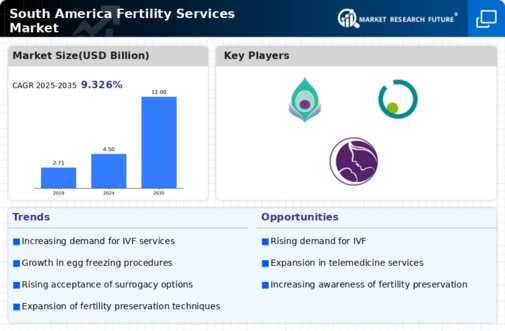The competitive insights of the South America Fertility Services Market reveal a dynamic and rapidly evolving landscape characterized by increasing demand for advanced reproductive technologies and improving healthcare infrastructure across the region. The market is primarily driven by the rising awareness of fertility issues, changing societal norms regarding family planning, and the growth in disposable income among the population. As the market expands, several key players have emerged, working to establish themselves through innovative services and strategic partnerships.
Companies are focusing on enhancing patient experience and treatment effectiveness, leading to competitive advantages in areas such as technology adoption, clinical research, and operational excellence. The competitive dynamics among the key players reflect a commitment to offering comprehensive fertility solutions that cater specifically to the unique needs of the South American demographic.Fertility Center of Brasil has established itself as a formidable entity within the South America Fertility Services Market, showcasing a strong reputation for its high success rates and patient-centric approach.
The center has invested significantly in advanced reproductive technologies, ensuring that it remains at the forefront of technological innovations such as in-vitro fertilization, egg freezing, and pre-implantation genetic testing. One of its notable strengths lies in its experienced medical staff and specialized reproductive endocrinologists, who are dedicated to providing tailored treatment plans for individual patients.
Furthermore, the Fertility Center of Brasil is known for its collaborative approach, often engaging in partnerships with leading healthcare providers and organizations, which enhances its service offerings and market presence in the region.Clinica Santa Maria operates with a strong focus on providing comprehensive fertility services within the South America Fertility Services Market, offering a range of treatments such as assisted reproductive technologies, hormonal therapies, and gynecological procedures. The clinic's dedicated team of specialists employs a multidisciplinary approach to patient care, which is one of its significant strengths, allowing for a holistic treatment experience.
Clinica Santa Maria has also made strategic moves, including mergers and acquisitions with other healthcare entities, enabling it to expand its footprint across South America. By integrating complementary services and advancing its technological capabilities, the clinic stands out in a competitive landscape. Its commitment to ongoing clinical research and partnerships with local and international fertility organizations fosters innovation and positions the clinic favorably in terms of service diversity and customer trust in the South American market.













